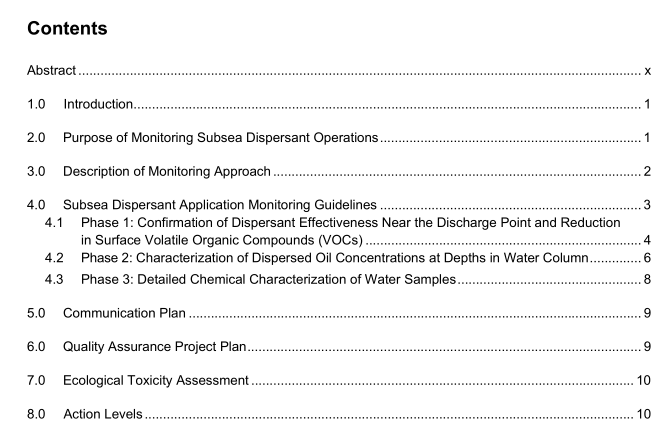API TR 1152 pdf download

API TR 1152 pdf download Industry Recommended Subsea Dispersant Monitoring Plan Version 1.0
Basic Requirements List
• Ship-capable gas chromatograph with flame ionization detector or equivalent instrument capable of measuring total petroleum hydrocarbons
• Transfer vehicles to shuttle samples from port to a shipping facility
• Shipping facility to transport samples to a laboratory
• Contract laboratory that is certified and accredited for hydrocarbon chemical analysis
5.0 Communication Plan
The communication plan will include a protocol addressing sample tracking, data management, data format, and an accessible digital data storage platform mutually agreed upon by the UC. Data managers should be designated for ensuring the collection and distribution of all data elements described hereafter. These include data generated by the units responsible for implementation of the Subsea Dispersant Operations Plan, the Subsea Dispersant Monitoring Plan, air monitoring data generated through implementation of the Safety Plan, and Source Control activities. All data collected and/or analyzed by the RP or the government (with the exception of data and/or analysis strictly associated with NRDA or legal investigations) will be available to the UC. Unless otherwise instructed by the UC, the communications plan may be based, to the extent applicable, on the NRT guidance for Environmental Monitoring for Atypical Dispersant Operations. Data reporting will be on a daily basis, when feasible, unless otherwise approved by the FOSC. The communications plan shall include, but may not be limited to:
• Air and Water quality data generated by activities described in Section 4.
• The amount of dispersant applied for the previous 24-hour period, in hourly intervals, if possible.
• Variations in the planned dispersant application +/-10% of the previous daily average.
• Water column dispersed oil loading reports.
• Dispersing potential assessment reports and recommendations.
• Daily subsea transport estimate of oil, dispersant, and dispersed oil plumes using the most current trajectory modeling available.
6.0 Quality Assurance Project Plan
The Quality Assurance Project Plan (QAPP) will address sample collection methodology, handling, chain of custody, and decontamination procedures to ensure the highest quality data will be collected and maintained. The QAPP will be developed in accordance with EPA Quality Assurance Project Plans 4 and 5, and recommendations from the UC. The QAPP should be based, as appropriate, on the NRT guidance on Environmental Monitoring for Atypical Dispersant Operations. Discrete samples will be tested at a laboratory approved by the OSC, with the concurrence of EPA and, as appropriate the states, and in consultation with DOC and DOI. The QAPP will include:
• An introduction that identifies project objectives and the project staff.
• A site description and background. The site description will include bathymetry, subsea currents (including temporal variations), and other relevant geological features. The site description will identify any relevant oil seeps or other potential sources of contamination (e.g., recent oil discharges), and relevant oil and/or natural gas infrastructure (e.g., oil platforms, subsea pipelines).
• A description of the sampling and monitoring protocols, data quality objectives, and health and safety implementation strategies included in this monitoring plan.
• Quality assurance (QA) to address chain of custody procedures, field records including logs, and qualitative data handling including photographs.
7.0 Ecological Toxicity Assessment
An ecological toxicity (ecotoxicity) assessment plan will be developed in consultation with the UC, and will use the best available technology. The primary method assumed to be relevant to this spill involves comparison of water quality data developed through implementation of this plan, to ecotoxicity benchmarks (EBs), established through consultation with the UC. The EBs would be based on species sensitivity distributions (SSDs). Ecotoxicity would be assessed by comparing TPH concentrations in water samples collected at appropriate depths to TPH based EBs. The ecotoxicity assessment would also be performed in areas where no dispersant has been applied to allow determination and comparison of ecotoxicity from physically dispersed and chemically dispersed oil.









